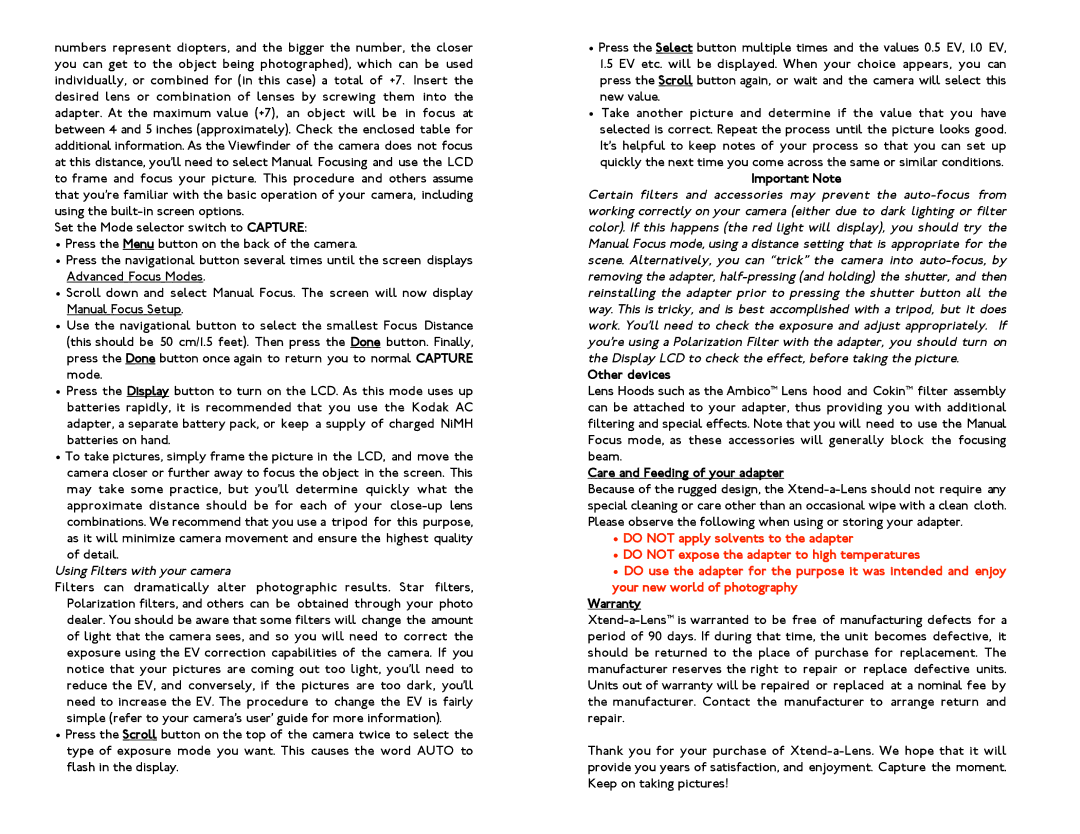numbers represent diopters, and the bigger the number, the closer you can get to the object being photographed), which can be used individually, or combined for (in this case) a total of +7. Insert the desired lens or combination of lenses by screwing them into the adapter. At the maximum value (+7), an object will be in focus at between 4 and 5 inches (approximately). Check the enclosed table for additional information. As the Viewfinder of the camera does not focus at this distance, you’ll need to select Manual Focusing and use the LCD to frame and focus your picture. This procedure and others assume that you’re familiar with the basic operation of your camera, including using the
Set the Mode selector switch to CAPTURE:
•Press the Menu button on the back of the camera.
•Press the navigational button several times until the screen displays Advanced Focus Modes.
•Scroll down and select Manual Focus. The screen will now display Manual Focus Setup.
•Use the navigational button to select the smallest Focus Distance (this should be 50 cm/1.5 feet). Then press the Done button. Finally, press the Done button once again to return you to normal CAPTURE mode.
•Press the Display button to turn on the LCD. As this mode uses up batteries rapidly, it is recommended that you use the Kodak AC adapter, a separate battery pack, or keep a supply of charged NiMH batteries on hand.
•To take pictures, simply frame the picture in the LCD, and move the camera closer or further away to focus the object in the screen. This may take some practice, but you’ll determine quickly what the approximate distance should be for each of your
Using Filters with your camera
Filters can dramatically alter photographic results. Star filters, Polarization filters, and others can be obtained through your photo dealer. You should be aware that some filters will change the amount of light that the camera sees, and so you will need to correct the exposure using the EV correction capabilities of the camera. If you notice that your pictures are coming out too light, you’ll need to reduce the EV, and conversely, if the pictures are too dark, you’ll need to increase the EV. The procedure to change the EV is fairly simple (refer to your camera’s user’ guide for more information).
•Press the Scroll button on the top of the camera twice to select the type of exposure mode you want. This causes the word AUTO to flash in the display.
•Press the Select button multiple times and the values 0.5 EV, 1.0 EV, 1.5 EV etc. will be displayed. When your choice appears, you can press the Scroll button again, or wait and the camera will select this new value.
•Take another picture and determine if the value that you have selected is correct. Repeat the process until the picture looks good. It’s helpful to keep notes of your process so that you can set up quickly the next time you come across the same or similar conditions.
Important Note
Certain filters and accessories may prevent the
Other devices
Lens Hoods such as the Ambico™ Lens hood and Cokin™ filter assembly can be attached to your adapter, thus providing you with additional filtering and special effects. Note that you will need to use the Manual Focus mode, as these accessories will generally block the focusing beam.
Care and Feeding of your adapter
Because of the rugged design, the
•DO NOT apply solvents to the adapter
•DO NOT expose the adapter to high temperatures
•DO use the adapter for the purpose it was intended and enjoy your new world of photography
Warranty
Thank you for your purchase of
